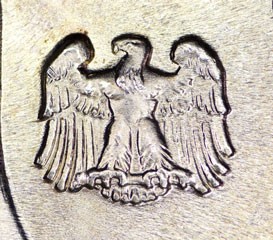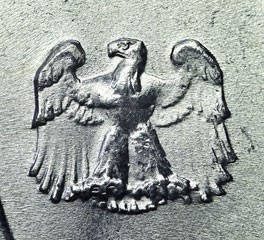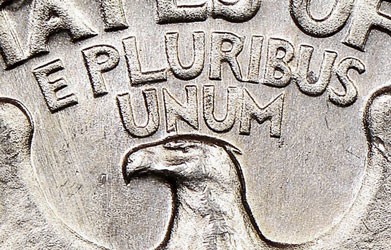USA Coin Album: Something's Not Quite Right
Posted on 12/14/2021
By
David W. Lange
Most collectors are aware that dies used for coining Proofs receive special polishing, but much less known is that sometimes Proof dies actually differ slightly in their design details from the corresponding dies intended for circulating coinage. Proof dies may have sharper features and slightly higher relief, though this is not universal.
Instead, it seems to have been the practice for just a few coin series, and even then it was not carried through the entire series span. The expectation is that the hubs used to produce these dies will not be used to sink dies for circulating coinage, but there are a number of instances where accidental or intentional lapses occurred.
In recent years, several dates of Lincoln Memorial cents have been found displaying features that contradict their intended service. For example, the reverse hub used to make dies for Lincoln Memorial cents typically had the letters A and M of AMERICA closely spaced and nearly touching, while dies for Proof coins were taken from a different hub on which these letters are clearly separated.
Nevertheless, circulating cents dated 1998(P), 1999(P) and 2000(P) are known with the “Wide AM” reverse, the die having been taken from the Proof hub. Conversely, Proof cents dated 1998-S and 1999-S may be found having the “Close AM” reverse intended for currency pieces. These coins represent unintentional errors on the part of the US Mint, and they make for highly sought varieties.
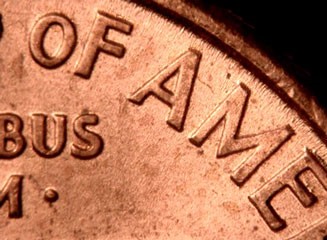 |
|
| This 1998(P) cent was unintentionally coined with a reverse die having the “Wide AM” feature only on the Proof hub. Click images to enlarge |
|
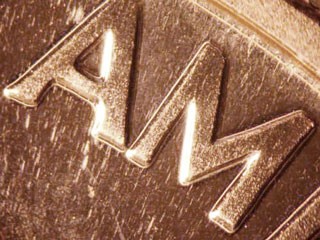 |
|
| Its companion is this 1999-S Proof cent displaying the “Close AM” hub typically used for circulating coins. Click images to enlarge |
|
A similar instance of this error may be found on 1958(P) and 1959(P) half dollars. In 1956 the Philadelphia Mint’s Engraving Department created a new reverse hub intended solely for use with Proof halves. This has much sharper eagle figure than that seen on circulating issues and earlier Proofs. This new hub was transitional during 1956, with dies from either the “Type 1” or “Type 2” reverses used for that year’s Proofs. Type 2 halves are slightly scarcer, but not enough to be expensive.
The circulating halves of that year through the end of the series continued with the Type 1 reverse, yet small numbers of 1958(P) and 1959(P) half dollars struck for circulation are known displaying the Type 2 reverse. In fact, one die for 1959(P) half dollars was sunk first with the Type 1 hub and then again with the Type 2. The blurred undertype remains partially visible, and this is a highly sought entry found in The Cherrypickers’ Guide to Rare U. S. Coin Varieties. Since these coins are not found with Prooflike fields, it’s doubtful that the dies were ever used to coin Proofs. Instead, this lapse was simply an error on the part of the Mint when creating non-Proof dies.
It’s important to point out the lack of Prooflike surface in this instance, because many coins struck for circulation during the 1950s and ‘60s intentionally were made from both obverse and reverse Proof dies. These were dies that had been retired from Proof service yet remained suitable for currency production. This situation occurred across all denominations from the mid-1950s through 1964, and many Philadelphia Mint coins of that period thus display some degree of Prooflike surface.
Of course, for most of these coins it’s impossible to actually prove that they were made from Proof dies. The quarter dollars, however, are another story, as the Proofs of that period used a distinctive reverse hub for the creation of dies. This “Type B” hub had the letters E and S of STATES clearly separated, whereas the “Type A” reverse intended for currency strikes had the letters nearly touching. Type B non-Proof quarters of the Philadelphia Mint are known for all dates 1956-64 and are highly collectible.
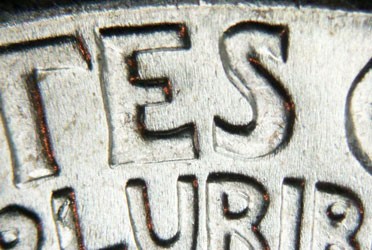 |
|
| The gap between letters E and S of STATES reveals the use of a retired Proof die in coining this non-Proof quarter dollar. Click images to enlarge |
|
One of my favorite varieties also represents the use of an incorrect hub, but it does not pertain to Proofs. Silver quarters dated 1964-D were coined well into 1965, and their production coincided with the first striking of 1965-dated quarters made of the new copper-nickel-clad composition. The hardness of the clad pieces required the introduction of a new reverse hub having shallower relief and sharpened details.
With dies for both reverses being used at the Denver Mint during 1965, a number of 1964-D silver quarters were struck using the new “Type C” reverse intended solely for the clad coins, rather than the “Type A” typical for 1964-D quarters. This distinctive hub is immediately evident in a side-by-side comparison. Given the great number of 1964-D quarters still being traded as bulk silver, it’s possible for a keen-eyed collector to cherrypick this very desirable variety (FS-901 in The Cherrypickers’ Guide).
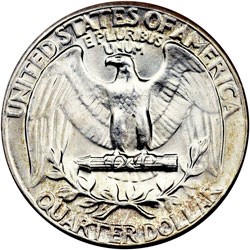 |
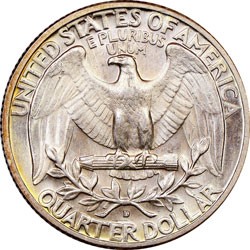 |
| The reverse of the 1964(P) quarter displays the normal, Type A reverse, while the 1964-D quarter is of the scarce variety having the Type C reverse intended for clad coins. Click images to enlarge |
|
David W. Lange's column, “USA Coin Album,” appears monthly in The Numismatist, the official publication of the American Numismatic Association.
Stay Informed
Want news like this delivered to your inbox once a month? Subscribe to the free NGC eNewsletter today!
